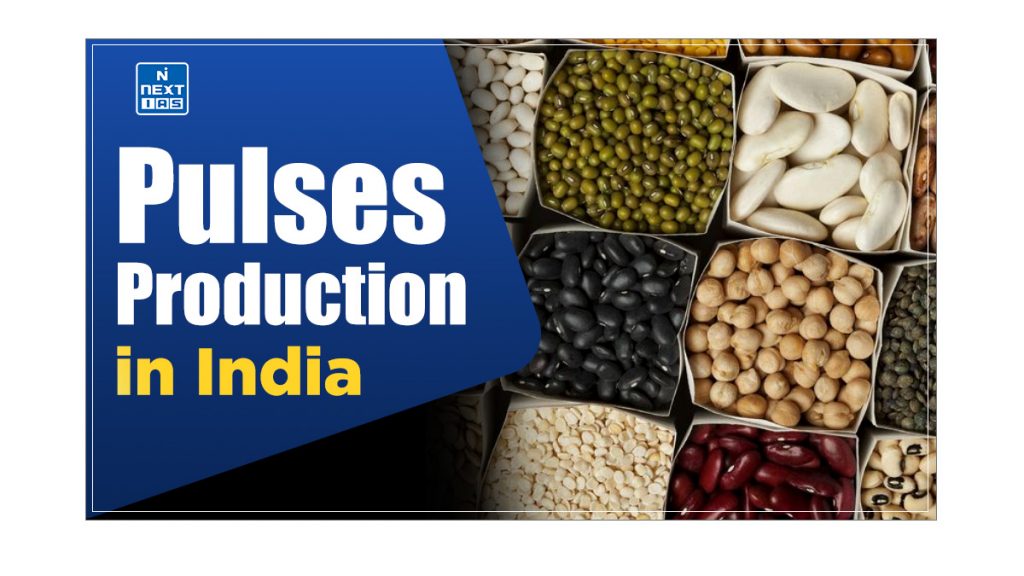
Pulses in India, the edible seeds of leguminous plants, are a cornerstone of global agriculture and nutrition. Beyond their significant role as a protein source for millions, pulses offer environmental benefits through their nitrogen-fixing properties, contributing to soil health and climate change mitigation. This article aims to study in detail the various types of pulses, their production, distribution, and significance in global agriculture.
About Pulses
- Pulses are the edible seeds of plants in the legume family. They are grown in pods and vary widely in shape, size, and colour.
- The United Nations Food and Agriculture Organization (FAO) recognises 11 types of pulses, including chickpeas, dry beans, dry broad beans, dry peas, cow peas, pigeon peas, lentils, bambara beans, vetches, and lupins.
- Beyond being an essential source of protein for a significant portion of the global population, pulses also contribute to healthy soils and climate change mitigation through their nitrogen-fixing properties.
- India is the leading producer of pulses, accounting for 25% of global production, the largest consumer, with 27% of world consumption, and a significant importer, representing 14% of global imports.
Types of Pulses
- Pulses are a broad category of legumes that include various types, each with distinct characteristics and nutritional profiles.
- They come in different shapes, sizes, and colours, ranging from small and round to large and flat.
- Some pulses are known for their quick cooking times, while others require soaking before preparation. They are used in various dishes, from soups and stews to salads and side dishes, and they provide a rich source of protein, fibre, and essential vitamins.
- Their diversity allows for versatility in cooking and contributes to a balanced and healthy diet.
Various types of pulses have been discussed in detail in the following section.
Gram
- Gram is the most important of all pulses. It prefers mild, cool (20-25°C) and comparatively dry climates (40-50 cm).
- It is a Rabi crop cultivated as pure or mixed with wheat, barley, linseed, or mustard.
- Mixed cropping helps to some extent to check the gram blight disease. Gram, like millets, has significantly suffered from wheat.
- Most gram comes from Madhya Pradesh, Maharashtra, and Rajasthan. Uttar Pradesh, Karnataka, Gujarat, and Andhra Pradesh (Rayalaseema region) are other significant producers.
Tur or Arhar
- Tur, also known as Arhar, is the second most crucial pulse widely consumed across South Asia.
- It serves as a major protein source for the Indian subcontinent and is a staple accompaniment to rice or roti (flatbread) throughout India.
- Tur is primarily cultivated as a Kharif crop, sown during the monsoon season and harvested before winter.
- It can also be grown as a Rabi crop in regions with milder winters.
- Typically, Tur is grown as a dry crop alongside other Kharif crops such as jowar, bajra, ragi, maize, cotton, and groundnut, rather than as a monocrop.
- Its cultivation conditions are similar to those of other pulses and millets.
- Maharashtra is the largest producer of tur in India, and Karnataka is the second largest producer. Bihar has the distinction of giving the highest yield per hectare.
Chickpeas (Garlic)
- Chickpeas, or garbanzo beans, are a staple pulse known for their high protein content.
- They are cultivated primarily in India, Australia, and Turkey.
- Chickpeas are widely consumed in India and play a significant role in the diet. They are used in various dishes like curries and salads.
- India is the largest producer and consumer of chickpeas, accounting for about 65% of global production.
- Australia and Turkey also contribute significantly to the global supply, with Australia being a major exporter.
Lentils
- Lentils are a vital source of protein and are cultivated in Canada, India, and Australia.
- Canada is the largest exporter of lentils, while India is a significant producer and consumer.
- Lentils are used in various dishes across India, such as dal (lentil soup).
- Australia is also a significant producer, with a focus on export markets.
Pigeon Peas
- Pigeon peas, or toor dal, are crucial in Indian cuisine, especially in South India.
- They are primarily grown in India, Myanmar, and Tanzania.
- India is the largest producer and consumer of pigeon peas, with significant production also occurring in Myanmar and Tanzania.
- Pigeon peas are used in various dishes and are a staple in Indian diets.
Dry Beans
- Dry beans encompass a variety of types, including kidney beans, black beans, and navy beans.
- Major producers include the United States, Brazil, and China.
- The United States and Brazil are leading exporters, while China is a significant producer and consumer.
- Dry beans are versatile and used in a range of dishes globally.
Cow Peas
- Cow peas are commonly grown in West Africa, India, and the United States.
- They are a staple in West African cuisine and are used in various traditional dishes.
- Cowpeas are also cultivated and consumed in India and the United States, though West Africa remains the primary region for their production and consumption.
Lupins
- Lupins are primarily grown in Australia and Europe. Australia is a leading producer and exporter of lupins, while Europe also produces lupins on a smaller scale.
- Lupins are used as food and feed and are known for their high protein content.
Bambara Beans
- Bambara beans are predominantly grown in West Africa. They are a traditional pulse in the region used in various local dishes.
- Bambara beans are largely produced and consumed in West African countries, contributing to local food security.
Vetches
- Vetches are grown in Europe, North America, and Asia.
- They are often used as fodder for livestock and for improving soil fertility.
- In Europe and North America, vetches are cultivated for their benefits in crop rotation and soil health.
Pulses Production in India
- Pulses production in India is crucial to the country’s agriculture and food security.
- India is the largest producer and consumer of pulses globally, contributing significantly to the global supply.
- The diverse agro-climatic conditions in India allow for the cultivation of various pulses grown throughout the year in different regions.
- Major pulse-producing states include Madhya Pradesh, Maharashtra, Rajasthan, and Uttar Pradesh.
- Despite being the largest producer, India often faces a shortfall in pulse production, leading to imports to meet domestic demand.
- The government has been implementing various initiatives to increase pulse production, improve yields, and ensure fair prices for farmers, aiming to make the country self-sufficient in pulse production.
Significance of Pulses in India
Pulses hold significant importance in global agriculture due to their multifaceted benefits:
- Nutritional Value – Pulses are rich in protein, dietary fibre, vitamins, and minerals, making them a crucial component of diets worldwide, especially in regions where meat consumption is low.
- Soil Health – Pulses have nitrogen-fixing properties, which improve soil fertility by converting atmospheric nitrogen into a form that plants can use. This reduces the need for synthetic fertilisers and enhances soil health.
- Sustainability – Pulses are environmentally friendly crops that require less water and energy than other protein sources. Their cultivation helps reduce greenhouse gas emissions and conserve natural resources.
- Economic Benefits – Pulses are valuable cash crops for farmers, providing income opportunities in both developing and developed countries. They also contribute to rural livelihoods and economic stability.
- Crop Rotation – Pulses are an essential part of crop rotation systems. Their ability to fix nitrogen benefits subsequent crops, leading to better yields and reduced dependence on chemical fertilisers.
- Diversity and Resilience – Pulses contribute to agricultural diversity, helping to manage pest and disease pressures and improving overall farm resilience. This diversity supports food security and reduces the risk of crop failure.
- Climate Change Mitigation – Pulses mitigate climate change by reducing the need for synthetic fertilisers and enhancing soil carbon storage. Their cultivation can help adapt to changing climate conditions by improving soil health and reducing agriculture’s carbon footprint.
Conclusion
Pulses are vital for human nutrition and are crucial in sustainable agricultural practices. From chickpeas and lentils to pigeon peas and cowpeas, each pulse type contributes uniquely to the global food system and local economies. With its diverse production and consumption patterns, India exemplifies the importance of pulses in diet and agriculture. As we continue to address food security and environmental challenges, the role of pulses in enhancing both human health and ecological balance remains ever-relevant.
Frequently Asked Questions (FAQs)
What are pulses?
Pulses are edible seeds of leguminous plants known for their high protein content and nutritional value.
What are the four types of pulses?
The four main types of pulses are beans, lentils, peas, and chickpeas.






